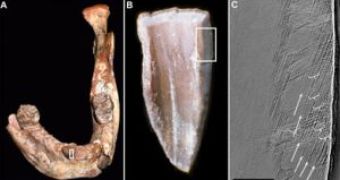What makes us different from the apes?
Scientists say that amongst many other traits, the long childhood and delayed maturity is a characteristic tracked now in the early members of our own species in Africa.
Previous studies showed that earlier hominids, like Australopithecus and Homo erectus, experienced short growth periods, more similar to chimpanzees than to modern humans.
This poses a puzzle about when long child development emerged in human evolution.
The new analyses of fossil teeth from a 160,000 years aged North African child show long-term growth patterns like in modern European children. It seems that this human trait, long childhood, emerged relatively late in the 4-million-year history of human evolution. "The early fossil humans tended to grow fast, have a shorter childhood and resemble chimpanzees in terms of their developmental profile. This is the oldest fossil we have that we see something like modern humans than earlier humans or apes", said study team member Tanya Smith of the Max Planck Institute for Evolutionary Anthropology in Germany.
The team employed a new imaging technique, X-ray synchrotron microtomagraphy, to assess tooth growth of an early human child without damaging the fossil lower jawbone.
Tooth growth, especially the time when the first molar erupts, shows the growth rates of the individual. With the age, the teeth depose new layers of enamel which, like the annual tree rings, signal their developmental rate and the individual's age when he/she died. "There are these daily lines and longer period lines in the teeth that are laid down during growth and that persist through millions of years," said Smith.
The about 8 years old fossil boy presented prolonged teeth growing like in modern humans. The child's first molar erupted around the age of 6, like in modern children, while in chimps this occurs around 4 years of age. "People speculate that by having a longer childhood, there's an increased period of time for learning. Organisms that have a greater learning period develop more complex social behaviors and have more complex social systems", said Smith.
"We don't have any securely dated material that's older than 200,000 years that people call Homo sapiens. These early fossils show a mix of primitive and derived features and paleoanthropologists are still debating whether they're modern or on the way to being modern," she added. "It would be great to bring in Homo erectus or some juvenile Neanderthal and really get at them with this approach".

 14 DAY TRIAL //
14 DAY TRIAL //